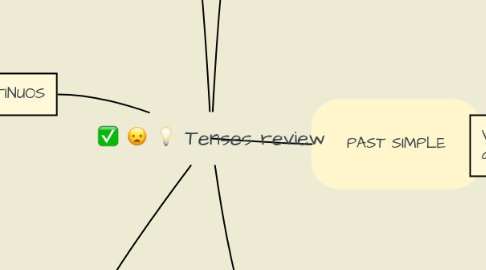Tenses review
da Alan B.


1. PAST CONTINUOS
1.1. The continuous past is used for actions that occurred at a specific time in the past. Like the present continuous, it is formed with the auxiliary verb "to be" and the gerund.
1.2. (+)She was reading a newspaper in the garden when her modher arrived
1.3. (-) She wasn¨t readingin the garden when her mother arrived
1.4. (?) Was she reading a newspaper in the garden when her modher arrived?
1.5. Affirmative: Subject + Verb to be in the past ("era" or "was") + main verb + ing + complement. Negative: Subject + Verb to be in negative past ("was not" or "were not") + main verb + ing + complement. Interrogative and short answers: Verb to be passed ("was" or "were") + subject + main verb + ing + complement.
2. PRESENT CONTINUOUS ON PRESENT PROGRESSIVE
2.1. (+) He is working at mach¨s proyect
2.2. (?) Is he working at mach´s proyect?
2.3. The Present Continuous or Present Progressive is a verb tense that is used to express actions that happen at the same moment in which it is being spoken
2.4. (-) He isn´t woeking at mach´s proyect
2.5. The Present Progressive or Continuous is a verbal form composed by the auxiliary TO BE, conjugated according to the subject of the sentence, and by the present participle form of the main verb (V + ing).
3. Future will and going to
3.1. There is a difference between these two ways of expressing the future. Generally "to be + going to" is used for actions that are going to happen very soon or to express a plan that you have. "Will" is used to express a promise, a prediction or something that you want to do in the future.
3.2. Will + subject + verb + remainder of sentence
3.3. "To be" + "going to" + verb:
3.3.1. Subject + will not + verb + remainder of sentence.
3.4. (+) I will go to the university
3.5. (-) I won't go to the university.
3.6. (?) Will you go to the university?
4. SIMPLE PRESENT
4.1. To conjugate the simple present we use the infinitive for the subjects "I", "you", "we" and "they" and for the third persons "he", "she" and "it", we add a "-s" to the End of the verb
4.1.1. (?) Do you play in the park?
4.1.2. (+) I play football in the park
4.1.3. (-) I don¨t play in the park
4.1.4. Affirmative The infinitive of the verb + s for the 3rd person singular I / you / we / they work He / she works Interrogative form Auxiliary DO / DOES + subject + verb (without 3rd person singular -s mark) Do I / you / we / they work? Does he / she / it work? Negative form Subject + Auxiliary DO NOT / DOES NOT + verb (without 3rd person singular -s mark)
